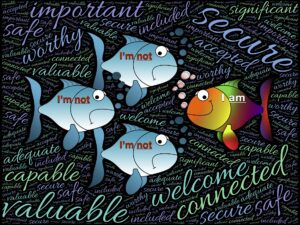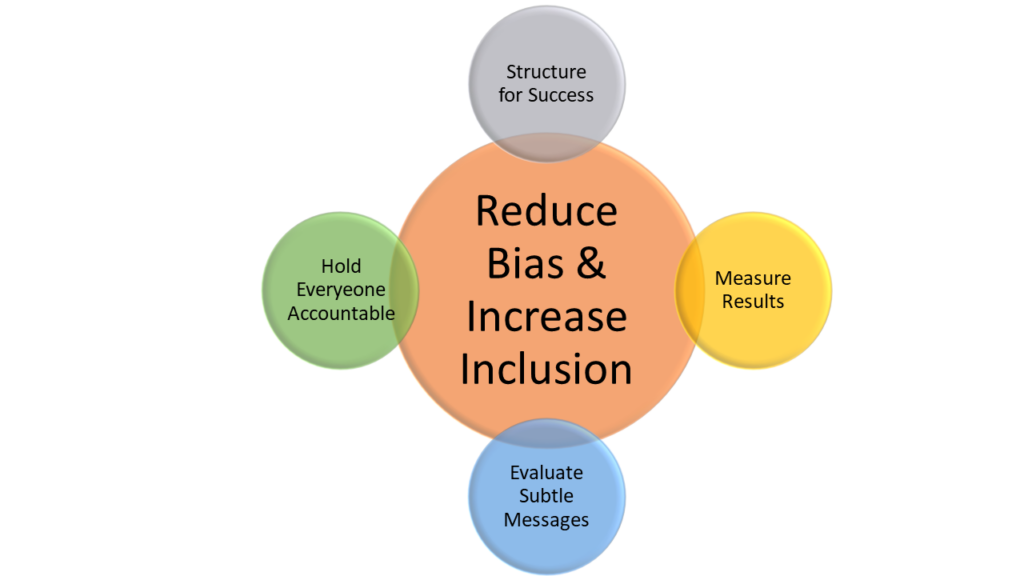Myth: Trickle Down Economics Works Since the days of Ronald Reagan, many have promoted the…

Implementation of DEI
Is DEI as Easy as ABC?
Companies of all sizes have incorporated the business case for diversity, equity and inclusion (DEI) during the last 20 years. A best practice for DEI among companies is not to embrace each component separately but to integrate them. Diversity is the understanding and recognition of individual differences and identities. It is the inherent mix of cultures among employees in a workplace.
To understand the concept, there must be an understanding of how equity differs from equality. Equality aims to ensure everyone gets the same things to enjoy whole, healthy lives. Equity, in contrast, should be embraced as a structural and systemic concept associated with fairness and justice.
What is the most crucial concept of DEI? Some advocates would support that inclusion is the most critical concept to the extent that the acronym is reversed among some companies as IDEA, the “A” standing for accessibility. Advocates for this acronym believe that diversity and equity cannot be achieved without companies establishing inclusive workplaces. More insights about DEI in the workplace can be found in Spectra Diversity’s blog,” Diversity, Equity & Inclusion at Work” — Spectra Diversity.
Spectra Diversity’s ABCDE Process for DEI
Embracing DEI in the workplace can be challenging but manageable if a process for implementation is in place. Similar to other methods, small and mid-size businesses (SMBs) may need more resources to embrace DEI. Spectra Diversity’s “ABCDE” process can help companies of all sizes embrace DEI.
This process can be helpful to SMBs that do not have a DEI leader to oversee the implementation of an inclusive environment.
A: Acknowledge Unconscious Bias
 Unconscious Bias is demonstrated among colleagues based on stereotypes associated with different cultures. The first step in acknowledging unconscious bias is recognizing that you have conducted such behavior. You can only learn how to mitigate unconscious bias if you are aware of it.
Unconscious Bias is demonstrated among colleagues based on stereotypes associated with different cultures. The first step in acknowledging unconscious bias is recognizing that you have conducted such behavior. You can only learn how to mitigate unconscious bias if you are aware of it.
There are various types of biased behavior that can be detected in a workplace:
- Diagnosis bias – this type of bias refers to labeling people, ideas, or objects based on initial opinions.
- Confirmation bias – is displayed when people search for information that supports their initial beliefs and values. It is hard to remove this type of bias in the workplace, but it can be managed through education and the development of critical thinking skills.
- Anchoring bias – heavy reliance on the first piece of information obtained about a topic occurs with this type of bias. It prevents embracing ideas objectively.
- Stereotype threats – stereotypes play an integral role in developing biased behavior. Meeting people from various backgrounds is the best way to invalidate stereotypes associated with underrepresented groups.
- Group think bias– this type of bias exists among teams that do not include individuals from diverse backgrounds. Teams that embrace the group think methodology has a homogenous composition among team members.
- Selection bias – prevents individuals from embracing holistic points of view with situations, topics, etc. A typical example is how people limit their purchases of a particular product due to the appeal of a specific brand instead of exploring their options.
Why is it beneficial for companies to acknowledge unconscious bias? Companies that do not own unconscious bias can incur costs that impact financial performance. True Office Learning, a learning pool company, revealed statistics from a Gallup study of expenses incurred by large companies due to biased behaviors in workplaces. These statistics are vital to share as they can also be incurred at SMBs:
- Employees impacted by discriminatory behavior are nearly three times as likely to be disengaged at work. According to the Gallup studies, active disengagement among US companies can result in costs of $450 billion to $550 billion annually. Annual costs related to disengagement at global companies can be higher due to gaps in cultural awareness.
- Biased behavior disrupts retention among employees. Employees who experience discriminatory behavior in the workplace usually do not maintain employment with their current employer beyond one year.
- Biased impedes innovation. Employees that feel that they are not working in an environment that embraces creation do not share ideas that can help with the progress of projects.
Google has adopted a four-pronged approach that can be adopted by SMBs to mitigate unconscious bias, as illustrated in the diagram below:
Design thinking is incorporated into Google’s approach to mitigating unconscious bias. Design thinking uses human-centered problem-solving to identify areas that may create biased outcomes.
B: Be Present and Pause
Inclusive leadership can play an integral role in embracing this process. Employees at companies not officially in leadership roles should be encouraged to be inclusive leaders in the workplace. An inclusive leader embraces the 6 C’s of characteristics and traits:
- Collaboration – a diverse thinking team is better than the sum of its parts.
- Cultural Intelligence – an inclusive leader will encourage to embrace colleagues through the same cultural lens.
- Curiosity – embracing different ideas and experiences enables growth among employees.
- Commitment – inclusive leaders must commit to DEI to experience success with implementation.
- Courage – risk-taking to incorporate DEI in a workplace is worthwhile when different cultures among colleagues are embraced.
- Cognizance – inclusive leaders have to recognize discriminatory behavior among colleagues to mitigate it.
C: Consider The Other’s Point of View
There is a particular type of dialogue that inclusive leaders should embrace to make sure that everyone’s point of view in a team or group setting is heard. This communication style is why companies are encouraged to develop diverse teams. Various studies have revealed that companies that have developed diverse teams experience above-average profitability than those without such teams.
Lower turnover is encountered when employees are in groups where their ideas are considered moving forward with work projects. Employing individuals with various viewpoints can help companies with achieving their goals.
Inclusive leaders need to acknowledge hopes and fears among colleagues in group discussions. People in group settings are initially fearful of expressing their ideas on a topic, with fear of rejection. Group participants may be nervous when expressing their opinions as they are getting familiar with their audience.
An environment has to be established among group sessions that allow participants to feel safe sharing ideas with their colleagues.
The type of questions asked during group dialogues makes a difference in bringing out various viewpoints and can be embraced positively during group settings. Open-ended questions are very effective during group dialogues. The questions can’t be answered by “Yes” or “No,” which encourages participants in group settings to express their points of view more elaborately. The questions encourage people to look for connections among ideas shared in group settings.
Barriers that prevent inclusive conversations among diverse teams should be mitigated. Most people have good intentions when speaking with colleagues but may need to realize that their communication style may be embraced as offensive. An example of offensive communication is microaggressions. Microaggressions are verbal and non-verbal lines of communication, usually targeted unintentionally to underrepresented groups.
Microaggressions occur due to the lack of understanding of the power of words. A typical example of a microaggression is when an African – American professional conducts a presentation among colleagues and receives comments such as: “That was a great presentation.” “You speak so eloquently.” Although these comments are intended to be complimentary, they may be offensive to the speaker. It should not be a surprise that an African – American professional can deliver a comprehensive presentation.
Tiffany Alvord, from the UCLA School of Law, conducted a great TED talk video about how microaggressions can be eliminated. The video can be found at Tiffany Avoid: “Eliminating Microaggressions: The Next Level of Inclusion” | TED Talk.
D: Determine What To Do Differently
It is typical for employees at SMBs to handle multiple responsibilities due to limited resources. Leaders at such companies can take this opportunity to change their recruiting strategy to hire individuals with diverse backgrounds and varied skill sets. An example of how hiring practices have changed is within the accounting profession.
Prior to the 1980s, large accounting firms strictly recruited students or experienced professionals with degrees in accounting. Currently, accounting firms have considered broader backgrounds of candidates at all levels. SMBs should embrace this diverse recruiting effort to meet the needs of their business.
For example, accounting professionals with an experience in marketing can help SMBs manage their financial needs and promote their services to prospective clients.
Cultural networking can help SMBs expand their business. Cultural networking can be obtained by extending sensitivity, empathy, and familiarity with people of different backgrounds. Many resources, such as books, podcasts, and online training modules, can help broaden an understanding of cross-cultural dynamics.
Companies should create environments that support inclusive conversations to occur in the workplace. The accounting firm Deloitte conducted a Global Human Capital Trends survey in 2020. The results of the study concluded that organizational culture (43%), leadership behaviors (33%), and personal relationships (24%) are the most significant factors that influence an organization’s ability to create inclusive environments in the workplace.
Other factors noted in the survey results were organizational purpose, opportunity and growth, the nature of the work, and fairness. The exhibit below illustrates the results of the survey. Survey respondents were mainly from large companies, but similar trends can be found at SMBs.
Mary -Frances Winters, a prominent diversity, equity, and inclusion leader and founder of The Winters Group, is also the author of the book, “We Can’t Talk About That At Work, How To Talk About Race, Religion, Politics, and Other Polarizing Topics.” The book is an excellent guide on how bold and inclusive conversations can occur in the workplace. Ms. Winters refers to six steps in the book on how to conduct inclusive conversations in the workplace:
- Step # 1 – Foster self and other understanding
- Step # 2 – Assess individual, team, and organizational readiness
- Step # 3 – Prepare for the conversation
- Step # 4 – Create shared meaning and find common ground
- Step # 5 – Explore where perspectives diverge
- Step # 6 – Interpret and bridge
E: Engage Others Through Dialogue 
Here are some other situations to consider when you are encouraging inclusive conversations (difficult conversations) to take place:
- Set a relaxed and open tone Welcome everyone and create a friendly and relaxed atmosphere in a group setting. Begin with ground rules for participants, and then ask them to add their ideas about what should be discussed and the discussion format.
- Be a good listener Refrain from speaking for others. Encourage participants to take advantage of the opportunity for their voices to be heard. Do not display judgment on opinions shared among participants as long as conversations are conducted respectfully. Provide acknowledgment of what has been shared among participants. Acknowledgment gives group leaders credibility if they show interest in what is shared among group participants. Here are examples of what a group leader can say when recapturing discussions among group participants:
-
- What you’re saying is……
- Let me see if I get this straight….
- I hear you say….
- What you’re telling me is that…
- In other words,…
- Let me give that back to make sure I’m clear about what you have shared with us.
- Stay impartial Consider how to move the discussion forward. Do not push your agenda on issues discussed in group settings.
- Be an effective leader with inclusive conversations in group settings Keep track of time. Pronounce participants’ names correctly. Don’t hesitate to ask for the correct pronunciation. Taking that extra step will assure group participants that you care about their identity and presence. Don’t be afraid of silence. Silence allows group participants to reflect on what they just heard from their colleagues. Remember that a discussion is not a debate. Don’t hesitate to re-establish boundaries. Make sure that there are equitable opportunities for all participants to speak. Do not let a participant monopolize the conversation.
- Communication styles and stereotypes Help participants appreciate and respect each other’s communication styles based on their cultural background. Some cultures value listening more than speaking. In others, taking a stand is of utmost importance. Participants in group settings should understand that cultural labels are usually unfair.
Spectra Diversity’s new assessment report holds critical insights for SMBs. SMBs need to determine how their DEI efforts are a right fit for their companies. More Information in the report can be found at Small-Medium sized biz -succeed-with- DEI . Contact us for more information at Spectra Diversity Contact Us.
Source: True Office Learning, “ The Cost of Unconscious Bias in the Workplace “, April 12, 2019
Source: Deloitte, “ 2020 Global Human Capital Trends” | Deloitte Insights
Source: Deloitte, “ Six signature traits of inclusive leadership” | Deloitte Insights



